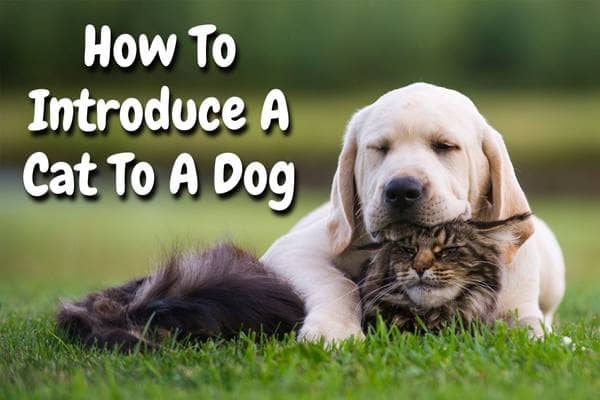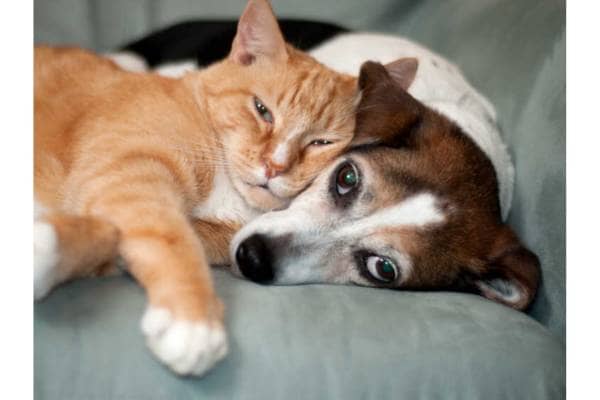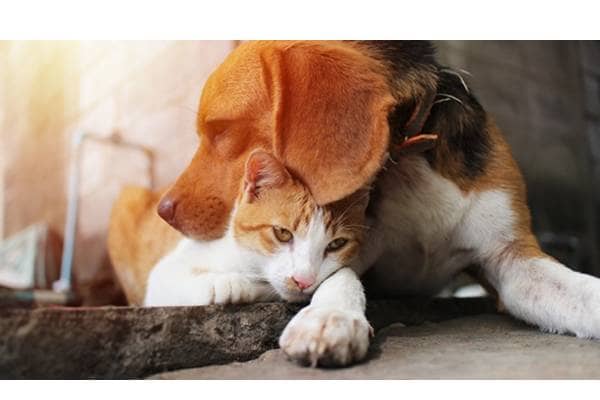How to Introduce a Cat to a Dog Safely and Successfully
Introducing a cat to a dog can be a delicate process, requiring careful consideration and strategic planning. The juxtaposition of these two distinct species may pose challenges that necessitate the implementation of appropriate techniques.

This article aims to provide guidance on how to successfully introduce a cat to a dog, ensuring their safety and well-being during the initial stages of their relationship. By following these steps, individuals seeking harmonious coexistence between their feline and canine companions can effectively navigate this potentially stressful situation.
The approach advocated here emphasizes the creation of a safe and separated space for both animals, allowing them to acclimate gradually through scent familiarization before progressing to supervised face-to-face interactions. Positive reinforcement strategies are recommended throughout the introduction process, promoting desirable behaviors and fostering mutual acceptance between the cat and dog.
Ultimately, patience is vital in establishing a positive foundation for long-term compatibility between these two diverse creatures.
Key Takeaways
- Start by introducing scents and allowing them to sniff each other’s bedding and toys
- Create separate spaces for each animal initially to provide safe spaces for retreat
- Monitor their interactions closely and reinforce calm behavior with rewards
- Gradually integrate the cat and dog, promoting a successful interaction and minimizing stress and aggression
Prepare a Safe and Separated Space
Creating a secure and isolated area for both the cat and dog is an essential step in introducing them to ensure their safety and minimize potential conflicts. The process begins by designating a separate space for each animal. This could be a spare room, a crate or kennel, or even baby gates to divide the living space.
It is important to create a gradual introduction plan that allows the animals to become familiar with each other’s scents and sounds without direct contact.
To ensure a calm environment, it is crucial to remove any potential stressors such as loud noises or sudden movements. Providing hiding spots, such as cardboard boxes or cat trees, can also help the cat feel safe during this initial period. Additionally, it is recommended to place food bowls and litter boxes in separate areas to avoid territorial disputes.
Once both animals have acclimated to their respective spaces, controlled visual introductions can begin. This can be done by using crates or baby gates that allow them to see but not touch each other. Over time, these visual encounters should be increased while monitoring their behavior closely.
By creating a secure and isolated area for both the cat and dog and ensuring a calm environment through careful planning, gradual introductions can take place effectively. Following these steps will increase the likelihood of a successful integration between the two animals while minimizing stress and potential conflicts.
Familiarize Them with Each Other’s Scents
Establishing a familiar scent between the two animals can foster a sense of comfort and familiarity, ultimately paving the way for a harmonious coexistence. One effective method to achieve this is by introducing the cat and dog through play. Engaging them in interactive play sessions with separate toys, such as balls or feathers, can help create positive associations with each other’s presence. This gradual exposure allows them to become accustomed to one another without feeling threatened or overwhelmed.
In addition to playtime, using pheromone diffusers can also aid in familiarizing the cat and dog with each other’s scents. Pheromones are chemical signals that animals produce naturally, which can have a calming effect on both species. By utilizing diffusers that release synthetic pheromones into the environment, it helps create an atmosphere of relaxation and reduces stress levels for both pets.
When introducing their scents, it is essential to allow each animal access to bedding or blankets used by the other pet. Swapping these items regularly will enable them to become accustomed to each other’s smells gradually. Additionally, placing these items near their respective resting areas will further promote familiarity and acceptance.
By incorporating these methods of introducing through play and using pheromone diffusers, pet owners can lay the groundwork for a successful introduction between their cat and dog. It is crucial to remember that every animal is unique and may require different lengths of time for adjustment; therefore, patience and careful monitoring are key during this process.
Supervised Face-to-Face Meetings
Facilitating supervised face-to-face meetings between the two animals allows for controlled interactions and can facilitate the gradual acclimation of both species to each other’s presence. These meetings should take place in a neutral space where neither animal feels territorial or threatened. It is important to closely monitor their body language cues during these encounters as they can provide valuable insights into their comfort levels and potential conflicts.
Professional guidance is highly recommended when introducing a cat to a dog, especially if either animal has shown signs of aggression or fear in the past. An experienced trainer or behaviorist can assess their behaviors, guide the introduction process, and address any issues that may arise.
To make these face-to-face meetings more enjoyable and relatable, consider incorporating the following nested bullet point list:
-
Engage in positive reinforcement techniques during the meetings:
-
Reward calm behavior with treats or praise.
-
Redirect any negative reactions by distracting them with toys or commands.
-
Gradually increase the duration of these supervised sessions over time:
-
Start with short sessions, gradually increasing them as both animals become more comfortable.
-
Monitor their body language closely for signs of stress or tension and adjust accordingly.
By following these guidelines and seeking professional assistance when necessary, pet owners can help ensure a smooth transition and foster a harmonious relationship between their cat and dog.
Positive Reinforcement and Rewards
Engaging in positive reinforcement techniques during face-to-face meetings can enhance the interactions between two animals and promote a harmonious relationship. Clicker training for cats and dogs is one effective method that owners can utilize to establish positive associations and encourage desirable behavior.
This technique involves the use of a clicker, which emits a distinct sound when pressed, followed by immediate reward. By associating the click with a treat or praise, both the cat and dog learn to associate the sound with positive experiences.
Using treats to encourage positive interactions is another valuable tool in introducing cats and dogs. Offering treats as rewards for calm behavior or successful interactions can help create positive associations between the two animals. It is important to use high-value treats that are particularly appealing to each animal, as this will increase motivation and reinforce desired behaviors more effectively.
Incorporating clicker training and utilizing treats helps create an environment where both animals feel rewarded for their appropriate behavior. This approach promotes cooperation, reduces stress, and fosters mutual respect during face-to-face encounters between cats and dogs.
The consistent application of these techniques establishes a foundation for building trust, improving communication, and ultimately fostering a harmonious relationship between the two species.
See also:
| The Secret Life Of Pooches: What Dogs Really Do When You’re Not Around |
Pawsome Pals: How Dogs Can Teach Us The Art Of Unconditional Love”
Gradual Integration and Patience
Gradual integration and patience are key factors in ensuring a smooth and successful introduction between two different species. When introducing a cat to a dog, it is important to take the time to build trust and establish boundaries for both animals. This process requires patience and careful observation.
Firstly, gradual integration involves slowly introducing the cat and dog to each other’s scents before any physical contact is made. This can be done by allowing them to sniff each other’s bedding or toys. It is also beneficial to create separate spaces for each animal initially, allowing them to become familiar with each other’s presence without feeling threatened.
During this period of integration, it is crucial to closely monitor their interactions and provide positive reinforcement when they display calm behavior. Rewards such as treats or praise can help reinforce good behavior and encourage a positive association between the two animals.
Additionally, establishing boundaries is essential in maintaining harmony between the cat and dog. Providing separate feeding areas, litter boxes, and safe spaces where each animal can retreat when needed will help minimize potential conflicts.
In conclusion, gradual integration and patience are vital when introducing a cat to a dog. Building trust and establishing boundaries are key elements in ensuring a successful interaction between these two different species. By following these guidelines, pet owners can promote a harmonious relationship between their furry companions while serving their needs effectively.
| Benefits of Gradual Integration | Importance of Patience | Strategies for Building Trust |
|---|---|---|
| Allows animals to adjust at their own pace | Prevents stress or aggression | Encourage positive associations |
| Helps identify any potential issues early on | Promotes understanding and acceptance | Provide rewards for calm behavior |
| Establishes a foundation of respect between animals | Builds confidence in unfamiliar situations | Allow supervised interactions only |
Frequently Asked Questions
How long does it usually take for a cat and dog to become comfortable with each other?
To help a cat and dog bond faster, individuals can take several steps. These include creating a safe and comfortable environment, gradual introductions with supervised interactions, positive reinforcement training, and providing separate spaces for each pet’s needs.
Can I leave my cat and dog alone together after they have been introduced?
It is important to gradually introduce a cat and dog to each other before leaving them alone together. Creating a safe and positive environment, providing separate spaces, and supervised interactions can help facilitate their coexistence.
What are some signs that my cat and dog are not getting along?
Signs of cat and dog conflict can include aggressive behaviors, such as growling or hissing, avoidance or hiding, and excessive territorial marking. Creating a peaceful environment for both pets involves providing separate spaces, gradual introductions, and positive reinforcement training.
Should I introduce my cat and dog through a barrier or gate before allowing direct interaction?
Direct interaction between a cat and dog should only occur after a period of introduction through a barrier or gate. This cautious approach ensures the safety of both animals, minimizing potential risks associated with their initial encounters.
Are there any specific breeds of cats or dogs that are more likely to get along with each other?
Certain cat and dog breeds have been observed to have higher compatibility levels than others. However, it is important to note that individual temperament and socialization play significant roles in determining their ability to get along with each other.
Conclusion
In conclusion, introducing a cat to a dog requires careful preparation, gradual integration, and patience.
Creating a safe and separated space allows the animals to adjust at their own pace.
Familiarizing them with each other’s scents helps establish a sense of familiarity.
Supervised face-to-face meetings ensure controlled interactions.
Positive reinforcement and rewards encourage positive associations.
Like a delicate dance between two strangers, introducing a cat to a dog is an intricate process that demands time and attentiveness for successful integration.


